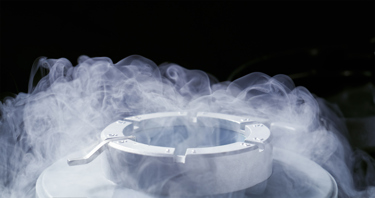Cryogenic Cooling: Powering The Future Of Infrared Technology

By John Oncea, Editor

Cryogenic cooling boosts IR tech by reducing thermal noise in detectors, enabling higher sensitivity and precision in fields from astronomy to military imaging.
True or false: following his death, Walt Disney’s head was cryogenically frozen, and it and his frozen body are hidden deep beneath Disneyland, either under Cinderella’s Castle or under the Pirates of the Caribbean ride.
False.
In fact, “The first documented case of cryonic preservation took place one month after Disney’s death,” according to Trust & Will. “The subject was Dr. James Bedford, a psychologist who was cryonically preserved and stored under the care of Alcor Life Extension Foundation, a nonprofit organization that leads the charge in cryonic preservation technology.”
Ted Williams, on the other hand … well, the Boston Red Sox legend and Hall of Famer did indeed have his head separated from his body in a process called neuroseparation, according to CBS News. “The operation was completed, and Williams’ head and body were preserved separately. The head is stored in a steel can filled with liquid nitrogen. It has been shaved, drilled with holes, and accidentally cracked 10 times. Williams’ body stands upright in a 9-foot-tall cylindrical steel tank, also filled with liquid nitrogen.”
What does any of this have to do with cryogenic cooling? Nothing, really. But it's pretty interesting, in a creepy kind of way.
What Is Cryogenic Cooling?
The aforementioned cryonic preservation is a specific application of cryogenics, which is the study and application of extremely low temperatures, according to the National Institute of Standards and Technology. So, too, is cryogenic cooling, but instead of freezing deceased individuals, it is a broader term encompassing the use of extremely low temperatures for various purposes.
Cryogenic cooling involves using extremely low temperatures to cool materials, typically below -238°F, according to QuEra. This is achieved by using cryogenic liquids like nitrogen or helium, or by using cryocoolers that circulate gases through a thermodynamic cycle. Cryogenic cooling offers numerous advantages, including rapid cooling, improved material properties, and enhanced performance in various applications.
Cryogenic cooling offers several advantages, first and foremost, a fast and efficient way to lower temperatures. It also can enhance the hardness, wear resistance, and fatigue life of materials and, by absorbing heat, help minimize temperature variations and thermal distortions. In certain applications, like machining, cryogenic cooling can improve the efficiency of the process by reducing cutting forces and surface roughness.
Numerous fields apply cryogenic cooling, including:
- Machining: Reducing heat and improving surface finish in machining processes.
- Superconductivity: Enabling the use of superconducting materials and devices.
- Electronics: Cooling high-power electronics and improving their reliability.
- Physics: Creating and maintaining low temperatures for research purposes, such as studying the behavior of materials at ultra-low temperatures.
- Transport Refrigeration: Cooling cargo compartments in refrigerated vehicles using liquid nitrogen.
- Medical Applications: Cryotherapy for treating conditions like cancer and sports injuries, or cryopreservation for storing biological samples.
Cryogenic Cooling And IR
Cryogenic cooling plays a critical role in enhancing the performance of infrared (IR) technologies across scientific, military, and industrial applications. By cooling detectors and sensors to ultra-low temperatures, cryogenic systems reduce thermal noise, enabling higher sensitivity and precision in capturing IR signals. Recent advancements in cryocooler efficiency and miniaturization have expanded their use in innovative projects, from space telescopes to night vision systems.
For starters, the James Webb Space Telescope’s Mid-Infrared Instrument (MIRI) relies on a cryocooler to maintain its arsenic-doped silicon detectors at below 7 kelvin (-447°F), writes NASA. This active cooling is essential for observing mid-infrared wavelengths (5–28 microns), which are crucial for studying distant galaxies and exoplanet atmospheres. Passive cooling via Webb’s sunshield suffices for near-IR instruments, but MIRI’s longer wavelengths demand extreme cold to minimize detector noise.
Similarly, the Legacy Survey of Space and Time (LSST) Camera employs cryogenic systems to cool its charge-coupled device (CCD) sensors to -238°F, drastically reducing thermal noise and improving image clarity for mapping billions of galaxies, the Cryogenic Society of America writes. These systems highlight the symbiotic relationship between cryogenics and high-resolution IR astronomy.
Cryogenic cooling is indispensable for night vision cameras and infrared sensors used in military systems. Advanced detectors, such as mercury-cadmium-telluride (HgCdTe) and indium antimonide (InSb), require cooling to cryogenic temperatures (60–100 K) to suppress electron noise and enhance image clarity. For example:
- Pulse tube cryocoolers are integrated into airborne and shipboard IR sensors for target detection and surveillance.
- High-operating-temperature (HOT) IR detectors now use Joule-Thomson (JT) coolers, which can stabilize temperatures above 100 K, balancing performance with reduced energy demands.
These technologies enable real-time thermal imaging in low-light conditions, critical for modern defense operations.
Recent breakthroughs aim to make cryogenic systems more practical. Researchers at the National Institute of Standards and Technology (NIST) redesigned pulse tube refrigerators (PTRs) to achieve 71% energy savings and 3.5x faster cooling to near-absolute zero, writes New Atlas. By optimizing helium gas flow and valve configurations, these systems could revolutionize applications like quantum computing and fusion energy.
Additionally, actively controlled JT coolers now offer flexibility for IR detectors operating at variable temperatures, though challenges remain in maintaining stability above 100 K, SPIE writes. Such advancements underscore the push toward compact, energy-efficient cryogenic solutions.
The integration of cryogenics with IR technology continues to evolve, driven by demands for higher resolution and lower power consumption. Projects like the Black Hole Explorer (BHEX) mission and next-generation Earth-observation satellites will rely on advanced cryocoolers to achieve unprecedented observational capabilities. As these systems become more accessible, their impact will extend beyond niche applications, enabling breakthroughs in both scientific research and everyday technology.
